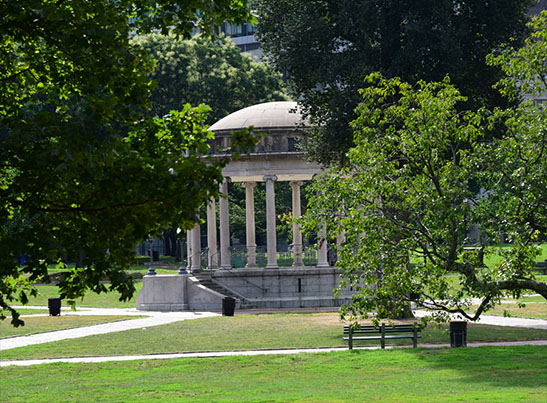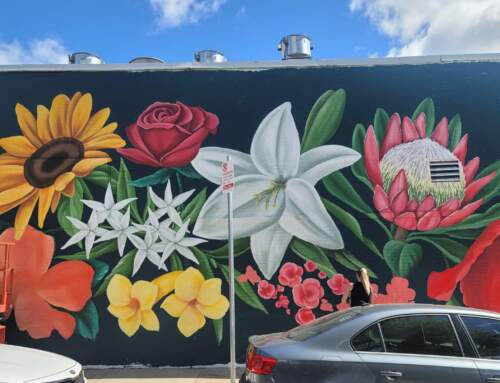By Richard Campbell
The long history of the Boston Common may be obscured to contemporary visitors who wade at the Frog Pond, take merry-go-round rides, or picnic on the lawn- but it has a history as a place of dissent that continues to echo down to this day. What is America’s oldest park began as a 42-acre private cow pasture, owned by a hermit English Clergyman William Blackstone (Blaxton) who received a patent for the property three years after the arrival of the Pilgrims, in 1623. Blackstone suggested to original settlers in Charlestown’s fetid swamp- who were suffering from a shortage of potable water- that they should cross what was then the peninsula of Shawmut to settle on the Boston side. Shawmut in Indian means “glistening fountain.” When Blackstone sold the property in 1634, for thirty shillings to the Puritans, their purchase marked the place as the nation’s first public park.
Like those who have followed them, many early citizens came to the Boston Common to be replenished, to exercise animals, celebrate, speak freely, prepare for war, and protest. As early as 1645 the Common served as a place to train militia- in the case of Charles La Tour, a French colonist and fur trader, who brought his men to seek refuge, having been blockaded out of St. John’s Harbor, in a fight with Menou d’Aulnay, his rival to be governor of Acadia. Despite being feted by Governor Winthrop, and helped with supplies, he and his men were forced to withdraw to their ship after an exercise on the Common, when crowds accused them of fomenting a “Popish conspiracy”. The whole expedition ended badly for La Tour, who sought refuge in Quebec. My point: almost from its very inception, the Boston Common had a reputation as a place for mustering military and meetings marked by dissent.
The Common often served as a little more than a public forum. Following the 1658 law enacted by Governor John Endecott all Quakers who were not residents of the colony were to be apprehended without warrant, and banished upon pain of death– or if they were too persistent, would be put to death by hanging on the Common. The Quaker’s views were so unappreciated that they were not only hanged on the Common, but tortured before audiences in all manner: whipping, clipping of the ears, and even boring their tongues with hot pokers. Endecott proved in the case of the four martyrs to be a most unforgiving individual, having a few of them repetitively “well whipped” and released on several occasions.
The large oak from which the famous four Quakers were hung was apparently near where the Frog Pond sits today. The Four “Boston Martyrs” were Marmaduke Stevenson, William Robinson, William Leddra, and Mary Dyer were led by two hundred soldiers to their hanging on October 27, 1859. Stevenson and Robinson were hung, but Dyer and Leddra who got to witness the gruesome events up close, were taken back to prison and brought back out in 1660 and 1661 to experience demise on separate occasions. Their crime: returning from exile several times after being banned for opposing the local religious order. It should be noted that around the world. October 27th is now International Religious Freedom Day in commemoration of the execution of the Boston Martyrs.
One might easily see the Boston Common through the lens of a series of emancipations from hysteria. By the time of the most famous witchcraft hysteria in New England, persecuting Quakers seemed like old hat. Interestingly, Judge Seawall, the Witch’s Judge, is interred nearby the Common in the Granary Burial Ground. Despite his rather unprincipled role in the witch trials in 1692-93, he was one of the very first colonials to openly oppose slavery. The Quakers, and later the Abolitionists, and Transcendentalist’s faced dark conservative forces who blamed them for all the countries ills- often playing upon people’s prejudices to lather up the crowds. Sounds a little too familiar.
Not many people seem to remember that the British encamped for eight years on the Boston Common before heading off to the battles of Lexington and Concord. The regulars were forced out after the Boston Tea Party to encamp on Castle Island, then Castle William- but not until after exhibiting their prowess to the local citizenry. The Liberty Tree, which was nearby the Common became a rallying point for the Colonials was at the corner of Essex and Washington Street. After the seizure of John Hancock’s ship by the Royal Navy, towns people dragged a customs official’s boat to the Boston Common, and burned it in protest. The Sons of Liberty tarred and feathered John Malcolm, a loyalist, under the Liberty Tree- which in those days, well within view of the Boston Common. One may not list that on their resumes for tolerance.
The Colonial burial ground on the Common contains the remains of famous Boston revolutionaries and British regulars buried side by side. By the colonial period, duels were held intermittently to defend a gentleman’s honor, or settle a score. In 1728, Peter Faneuil’s friend Henry Phillips, ran a sword through Benjamin Woodbridge in one such duel over a card game, and escaped via ship to France. Years later, Abolitionist William Lloyd Garrison narrowly escaped being dragged to the Boston Common for a tarring and feathering 1835. When people think about the rancor of today, maybe they should remember that it was the Republican party of Lincoln, who were the chief opponents of slavery, and it was Massachusetts Republican Senator Charles Sumner who was beat senseless with a cane on the floor of Congress by South Carolina Democratic Congressman Preston Brooks, after he gave a speech in which labeled Brook’s cousin as a “pimp for slavery.” Vitriol is not exactly new.
We see the nation mirrored back to us through the Boston Common. For who cannot gaze upon the statue by Auguste Saint-Gaudens of the Massachusetts 54th in wonder at the role of African Americans in Massachusetts Civil War history. By 1908 upon his death, George Parkman bequeathed something over five million dollars to the city of Boston for the preservation of the Boston Common, thus the bandstand dedicated in his name. In his will he said: “To the city of Boston in the hope and expectation that the Boston Common shall never be diverted from its present use as a public park for the benefit and enjoyment of its citizens.” For years the Common also served as a place of recreation and refuge, as well as the hallowed ground where dissenters challenge the world. The speeches and events of our forefathers would be seen as extraordinarily erudite next to modern day marches; but the fair sentiment is that Boston is still the Athens of America, and no matter what has gone before, we can be assured that our ancestors did not want us to fight the Civil War again.






